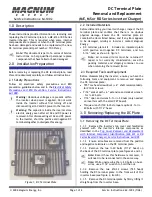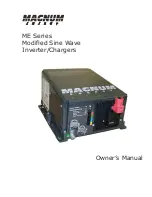
P
AGE
4
M
IDIAN
E
LECTRONICS
I
NCORPORATED
2 OVERVIEW
The PDE-1 is a multi-format paging and dialing
encoder. It will support up to 10 different formats
simultaneously from the over 35 available. The user-
friendly menu system makes it as easy to use as a cell
phone.
2-Tone Formats:
AVCALL, GE, REACH, and most
Motorola 1+1 and 2+2 plans. In addition, the ‘any 2-
tone’ feature allows for direct entry of any 2 arbitrary
frequencies to support PLECTRON and other 2-tone
formats without a standardized code plan.
Other Tone Formats:
DTMF, Pulse tone (1500 or
2805), 5/6-tone EIA, EUROSIGNAL, ZVEI, DZVEI,
DDZVEI, EEA, NATEL, and MODAT.
Digital Formats:
POCSAG 512, 1200, 2400, numeric
or alphanumeric.
10 Flexible Pager Profiles:
Allows up to 10 different
pager types in the same system.
User Database:
Allows up to 155 names and numbers
to be stored for easy access. Call a pager by name or
number.
Other Features:
10-entry speed dial list. Saved
message list allows 10 ‘canned’ alphanumeric
messages up to 25 characters long to be saved for
instant access. Security feature helps prevent
unauthorized personnel from tampering with the PDE
configuration. Can operate as a local remote control
with optional microphone. Outgoing pages can be
logged to a serial printer or PC with optional cable.
3 INSTALLATION
INSTRUCTIONS
Installation Note:
Midian products utilize CMOS integrated
circuits, which are susceptible to damage from high static
charges. Be sure to follow standard antistatic procedures
when handling, including using grounded workstations and
soldering irons and wearing grounding bracelets.
3.1 R
ADIO
I
NTERFACE
Radio Interface connector P1 is an 8-pin
RJ-45 style connector in the center of the
back panel.
+V IN (P1-5) [Red]
The PDE can be powered either by an optional wall
transformer or by the radio power supply. Connect this
wire to the radio power source provided it is between
12 and 15 VDC.
If using a wall transformer, make sure the voltage is
between 12 and 15 VDC and the current rating is at
least 500mA. Also, be certain that positive is
connected to the center pin (inside sleeve).
GROUND (P1-6) [Black]
Connect to radio ground.
AUDIO INPUT/RX IN (P1-8) [Blue]
This connection is only required if you wish to hear
radio audio through the PDE speaker. Connect to a
point in the radio where squelch controlled receive
audio is present at a constant level.
AUDIO OUTPUT/TX OUT (P1-4) [Green]
For tone formats you can usually connect to the mic-hi
input of the radio. The output impedance of the PDE
can be adjusted if necessary by replacing leaded
resistor R81 with an appropriate value. For digital
formats (POCSAG), it may be necessary to connect
directly to the modulator inside the radio.
PTT OUTPUT (P1-3) [Yellow]
This open collector output provides a ground to key-up
the radio when transmitting. If connecting to a relay in
the radio, make sure the coil is bypassed with a diode
to eliminate counter-EMF.
COR INPUT (P1-1) [Gray]
This connection is required only if you desire to
activate the
Busy Lockout
feature of the PDE. Connect
to a point in the radio squelch or CTCSS circuit that
changes logic level when carrier (or CTCSS) is
detected. A radio whose circuitry provides a logic-low
or logic-high can readily turn Q1 on and off. If only a
high level is provided, it may be necessary to move
R40 from its pull-up to its pull-down position.
MONITOR OUTPUT (P1-7) [Orange]
This output can be used to control the monitor function
of the radio using the <MONITOR> button on the PDE.
This is an open collector output which changes state
each time the <MONITOR> button is pressed.
SQ OUT/LTR IN (P1-2) [Brown]
This wire is not used by the PDE.
3.2 J
UMPER
S
ETTINGS
There are two user configurable jumpers, JU1 and
JU4. Both are installed at the factory. JU1 allows
signaling audio to be heard in the local speaker. If this
is not desired, cut JU1.
JU4 controls the output impedance of transmit audio.
See
OUTPUT LEVEL
below to determine if JU4 will
need to be cut.
3.3 A
DJUSTMENTS
Once the unit has been connected to the radio, several
adjustments must be made to achieve proper
operation. It will be necessary to open the unit. Use the
pictorial to identify the location of the following trim
pots: R32 near connector P3, R51 near IC U6, and
R105 near the volume control.
Содержание PDE-1
Страница 18: ...PAGE 18 MIDIAN ELECTRONICS INCORPORATED 6 3 MENU SYSTEM MAP...
Страница 20: ...This page intentionally left blank...
Страница 24: ...This page intentionally left blank...





































